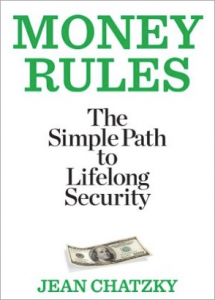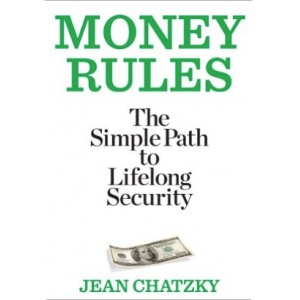 When economic times were flush, it felt relatively easy to figure out the next financial move to make. Today it feels like many of us are on a rapidly moving financial freeway with poor money signage.
When economic times were flush, it felt relatively easy to figure out the next financial move to make. Today it feels like many of us are on a rapidly moving financial freeway with poor money signage.
Should you pay off student loan debt or start saving for retirement? Should you save for your child’s education or save for your retirement? Should you buy a home, and if so, how much can you afford?
We all need sound money guidance and clear direction.
Thankfully, Jean Chatzky has a new book out called “Money Rules: the simple path to lifelong security” which gives us precisely that. In this slim guide, rich with wisdom, Jean gives 94 simple guidelines to restore financial sanity to your life.
To kick off Financial Literacy Month, here are 3 of my favorite “Money Rules” from Jean’s delightful book.
1. The More Time You Spend Looking, The Less Happy You’ll Be With What You Find.
Jean highlights research showing that college grads searching intently for the perfect job tended to earn 20% more, but were not happier than their peers who were content with “good enough.” Amen, sista! In a land were almost anything is possible, it can often feel like nothing is enough. I’ve found that setting boundaries, from the amount of time you will allow yourself to research an item you are shopping for, to a dollar amount you will spend on a vacation, shifts your focus to maximizing what you currently have. That in turn can dramatically increase what I call your “money-joy return on investment.”
2. Live Below Your Means. Period.
Jean suggests striving to save at least 10% of what you earn (and ups that to 15% if you are 35 years or older and are just starting to save). Alas, most of us are not doing this. As Jean points out in another rule I love (“The Joneses Are In Debt”), in the US roughly 115 million of us have credit card debt, and amongst this group the average debt per household is over $15,000. Personally, I think a big culprit is unrealistic media images. I’ve long wished there’d be an academic study that adds up the real cost of what it would take to maintain the kind of “middle class” lifestyle portrayed in many of the police or medical dramas. My hunch is that this lifestyle would cost 30-50% more than what those jobs could realistically support. Women have long been tormented by trying to look like models in magazines – models who themselves don’t really look like that because their images were airbrushed. The same goes for our national perception of what realistic “average” lives look like, thanks to Media Gone Wild.
3. Boring Is Better.
Jean says this in the section devoted to investment advice, and as a former active portfolio manager I couldn’t agree more. Over the long run, study after study shows that low-cost, highly diversified – but B.O.R.I.N.G. investments such as broad based index funds and ETFs out perform their sexier siblings, such as the hot stocks or investment themes of the year. To me, it’s like two cars driving along a toll road. One is going super fast, weaving in and out of traffic. The other is going steady at speed limit. They both arrive at the toll booth around the same time, but guess who is calmer, and whose car is in better condition? Yep, the boring driver. Same goes for investing.
For more Money Rules of the road, have your own private Financial Literacy Month Celebration by treating yourself to a copy of Jean’s latest book.

